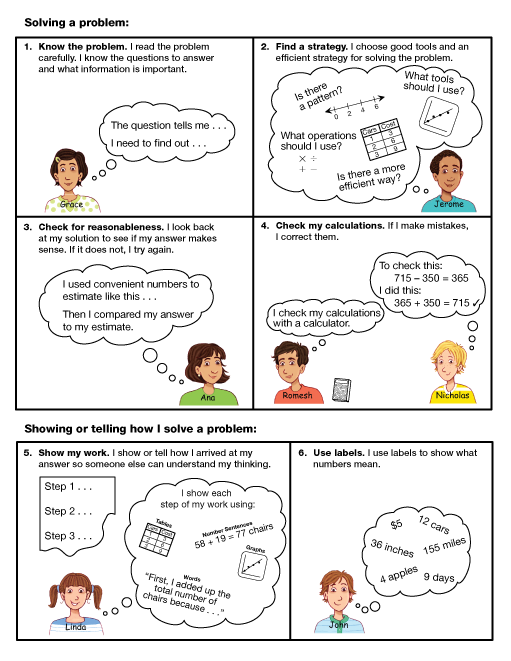| Key Ideas in Unit 2 |
L1 SG |
L1 SAB |
L1 TG |
L2 SG |
L2 SG |
L2 SG |
L2 DPP |
L2 DPP |
L2 TG |
L3 SG |
L3 SAB |
L3 DPP |
L4 SG |
L4 SG |
L4 SG |
L4 TG |
L4 DPP |
L4 DPP |
||
| Unit 2 Expectations | ||||||||||||||||||||
Math Content |
||||||||||||||||||||
|
Data 2 Data Representation: Select and create appropriate representations, including tables and graphs, for organizing, displaying, and analyzing data. |
||||||||||||||||||||
E1 |
Make a point graph. (Algebra 2) [MP4] [5.G.2] |  |
 |
|||||||||||||||||
|
Data 3 Data Description: Describe a data set by interpreting graphs, identifying patterns, and using statistical measures, e.g., average and range. |
||||||||||||||||||||
E2 |
Read a table or graph to find information about a data set. (Algebra 2) [MP4, 7] |  |
 |
 |
||||||||||||||||
|
Data 4 Using Data: Apply relationships and patterns in data to solve problems, develop generalizations, and make predictions. |
||||||||||||||||||||
E3 |
Model real-world situations with tables and point graphs. (Algebra 2) [MP1, 2, 4, 5] [5.G.2] |  |
 |
|||||||||||||||||
|
Geometry 4 Geometric Reasoning: Use visualization, spatial reasoning, and geometric modeling to solve problems. |
||||||||||||||||||||
E4 |
Recognize and generalize geometric relationships in problems involving the area and perimeter of rectangles. [MP1, 2, 4, 8] [4.MD.3, 3.MD.5, 6, 7, 8] |  |
 |
 |
 |
 |
||||||||||||||
E5 |
Make shapes (polygons) with given measurements (width, perimeter, or area). [3.MD.7, 8] [MP3] |  |
 |
 |
 |
 |
||||||||||||||
|
Measurement 2 Measurement Skills: Use measurement tools, appropriate techniques, and formulas to determine measurements. |
||||||||||||||||||||
E6 |
Find the perimeter of rectangles and irregular shapes by counting units and adding. [3.MD.7, 8] |  |
 |
 |
 |
 |
 |
 |
||||||||||||
E7 |
Find the area of rectangles and irregular shapes by counting, adding, or multiplying. [3.MD.7, 8] |  |
 |
 |
 |
 |
 |
|||||||||||||
Math Facts |
||||||||||||||||||||
|
Number 3 Computation and Estimation: Use efficient and flexible procedures to compute accurately and make reasonable estimates. |
||||||||||||||||||||
E8 |
Demonstrate fluency with subtraction facts. [2.0A.2] |  |
 |
 |
 |
|||||||||||||||
Math Practices |
||||||||||||||||||||
| MPE1 | Know the problem. I read the problem carefully. I know the questions to answer and what information is important. [MP1] |  |
||||||||||||||||||
| MPE2 | Find a strategy. I choose good tools and an efficient strategy for solving the problem. | |||||||||||||||||||
| MPE3 | Check for reasonableness. I look back at my solution to see if my answer makes sense. If it does not, I try again. | |||||||||||||||||||
| MPE4 | Check my calculations. If I make mistakes, I correct them. [MP6] |  |
 |
|||||||||||||||||
| MPE5 | Show my work. I show or tell how I arrived at my answer so that someone else can understand my thinking. [MP3] |  |
 |
 |
||||||||||||||||
| MPE6 | Use labels. I use labels to show what numbers mean. [MP3, MP2] |  |
 |
|||||||||||||||||

Yellow
Green
Blue
Red
Magenta
Remove














